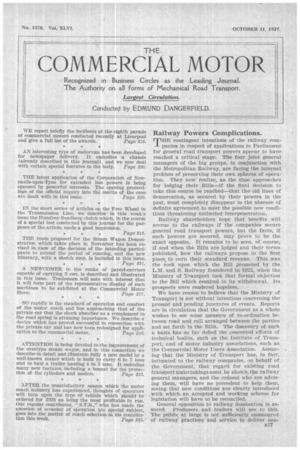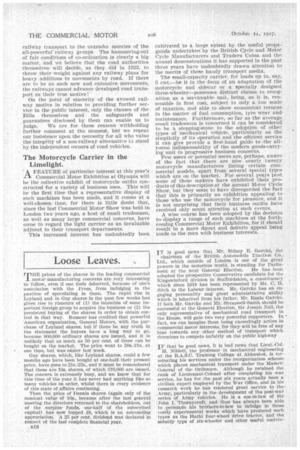THE
Page 43

Page 44

If you've noticed an error in this article please click here to report it so we can fix it.
COMMERCIAL MOTOR
Recognized in Business Circles as the Leading Journal.
The Authority on all forms of Mechanical Road Transport.
Largest Circulation.
Conducted by EDMUND DANGERF1ELD.
WE report briefly the incidents of the eighth parade of commercial motors conducted recently at Liverpool and give a full list of the awards. Page 216.
AN interesting type of motorvan has been developed for newspaper delivery. It embodies a chassis (already described in this journal), and we now deal with certain special features in the body. Page 220.
THE latest application of the Corporation of Newcastle-upon-Tyne for extended bus powers is being opposed by powerful interests. The opening proceedings of the official inquiry into the merits of the case
are dealt with in this issue. Page 286.
IN the short series of articles on the Free Wheel in the Transmission Line, we describe in this week's issue the Butnfrey-Sandberg clutch which, in the course of a special test conducted by this journal for the purposes of the article, made a good impression.
* • Page 218. THE route proposed for the Steam Wagon Demonstration which takes place in November has been revised in view of the decision of the intending participants to extend the period of running, and the new itinerary, with a sketch map, is included in this issue. Page 221.
A NEWCOMER to the ranks of parcel-carriers capable of carrying 5 cwt. is described and illustrated in this issue. Tradesmen will note with interest that it will form part of the representative display Of such machines to be exhibited at the Commercial Motor • Show. Page 217.
SO rapidly is the standard of operation and comfort of the motor coach and bus approaching that of the private car that the shock absorber as a complement to the road spring is attaining importance. We describe a device which has proved successful in connection with the private car and has now been redesigned for appli
cation to the commercial motor.. Page T232.
ATTENTION is being devoted to the improvement of the overtype steam wagon, and in this connection we describe in detail and illustrate fully a new model by a well-known maker which is built to carry.0 to 7 tons and to haul a trailer hauling 4 to 5 tons. It embodies many new features, including a bonnet for the protec tion of the cylinders and motion. Page 222.
AFTER the unsatisfactory season which the motor coach industry has experienced, thoughts of operators will turn upon the type of vehicle which should be ordered for 1928 as being the most profitable to run. Our regular contributor, " S.T.R:," who has made the question of economy of operation his special Subject, goes into the matter of coach selection in his contribu
tion this week. Page 225.
Railway Powers Complications.
• MITE contingent intentions of the railway com-1panics in respect of applications to Parliament for general road transport powers appear. to have reached a critical stage. The four joint general managers of the big groups, in conjunction with the Metropolitan Railway, are facing the internal problem of preserving their own spheres of operation. They now realize, as the time approaches for lodging their Bills—if the final decision to take this course be reaChed—that the old lines of demarcation, as secured by their powers in the past, must completely disappear in the absence of definite agreement to meet the possible new conditions threatening unlimited interpenetration. Railway shareholders hope that benefits . will accrue to the railways if the companies secure general road transport powers, but the facts, if such 'powers are secured, may prove to be the exact opposite. It remains to be seen, of course, if and when the Bills are lodged and their terms published, how the railways propose in the first place, to earn their standard revenue. This was the rock upon which the Bill promoted by the L.M. and S. Railway foundered in 1922, when the Ministry of Transport took that formal objection' to the Bill which resulted in its withdrawal. Its prospects were rendered hopeless. • We have reason to believe that the Ministry of Transport is not without intentions concerning the present and pending junctures of events. Reports are in circulation that the Government as a whole wishes • to see some measure of co-ordination between road and rail arranged between the parties and set forth in the Bins. The discovery of such a basis has so far defied the concerted efforts of technical bodies, such as the Institute of Transport, and of motor industry .associations, such as the Commercial Motor Users Association. Assuming that the Ministry of Transport has, in fact, intimated to the railway companies, on behalf of the Government, that regard for existing road transport undertakings must be shown, the railway general managers, and the coinsel who are advising them, will have no precedent to help them, seeing that new conditions are clearly introduced • with which an accepted and working scheme for legislation will have to be reconciled.
General opposition to railway domination is assured. Producers and traders will see to this. The public at large is not sufficiently enamoured of railway practices and service to deliver non railway transport to the 'intender mercies of the all-powerfuf railway groups. The hammering-out of fair conditions of co-ordination is clearly a big matter, and we believe that the road, authorities themselves will decide, as they did in 1922, to throw their weight against any railway plans for heavy additions to movements by road. If there . are to be no such new and extensive movements, the railways cannot advance developed road transport as their true motive !
On the point of sincerity of the avowed railway motive in relation to providing further service in the public interest, only the clauses of the Bills themselves and the safeguards and guarantees disclosed, by them can enable us to judge. We are for these reasons withholding further comment at the moment, btrt we repeat our insistence upon the necessity for all who value the integrity of a non-railway alternative to stand by the independent owners of road vehicles.
The Motorcycle Carrier in the Limelight.
' A FEATURE of particular interest at this year's IX Commercial Motor Exhibition at Olympia will be the collective exhibit of motorcycle outfits constructed for a variety of business uses. This will he the first time that a representative display of such machines has been. made, and it comes at a well-chosen time, for there is little doubt that, since the last Connnercial 'Motor Show Was held in London two years ago, a host of small tradesmen, as well as many large commercial concerns, have come tb regard the light carrier as an invaluable adjunct to their transport departments.
This increased interest has undoubtedly been cultivated to a large extent by the useful propaganda undertaken by the British Cycle and Motor Cycle Manufacturers and Traders Union and the annual demonstrations it has supported in the past three years have undoubtedly drawn attention to the merits of these handy transport media.
• The small-capacity carrier, for loads up to say, 5 cwt.—be it in the form of an adaptation of the motorcycle and sidecar or a speciallydesigned three-wheeler—possesses distinct claims to recognition as a serviceable unit, being, as it is, reasonable in first cost, Subject to only a low scale of taxation, and able to show economical returns In the matter of fuel consumption, tyre wear andmaintenance. Furthermore, se far as the average small tradesman is concerned it can be considered to be a steppingstone to the adoption of other typesof mechanical vehicle, particularly as the simplicity of its operation and the efficient service it can give provide a first-hand guide to the allround indispensability of the modern goods-carrying. unit to progressive business concerns. • Few users or potential users are, perhaps, aware of the fact that there are now nearly twenty motorcycle manufacturers listing certain commercial models, • apart from several special types which are on the market. For several years past . some of these makers have exhibited their products of this description at the annual . Motor Cycle Show, but they seem to have disregarded the fact that this is primarily an exhibition appealing to those who use the motorcycle for pleasure, and it is not Surprising that their business outfits have received only scant attention at such events.
A wise course has been adopted by the decision to display a range of such Machines at the forthcoming Commercial Motor Exhibition, for it should result in a More direct and definite a_ppeal being made to the man with business interests. ,




















































































































